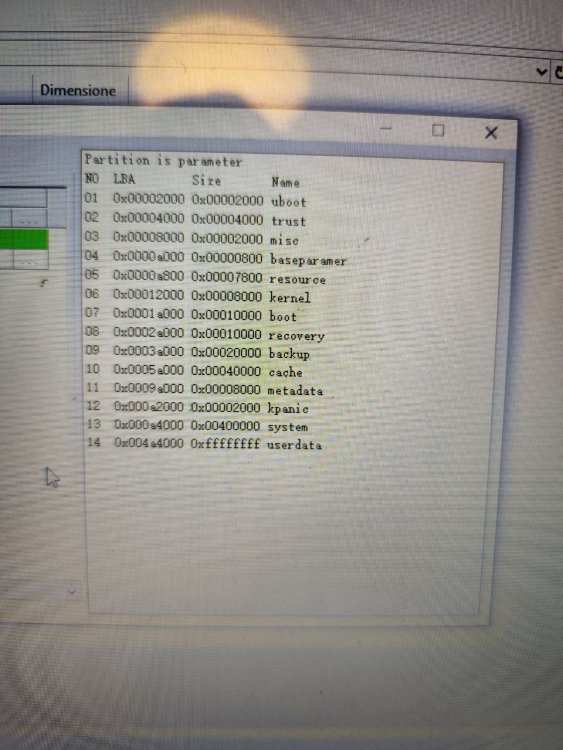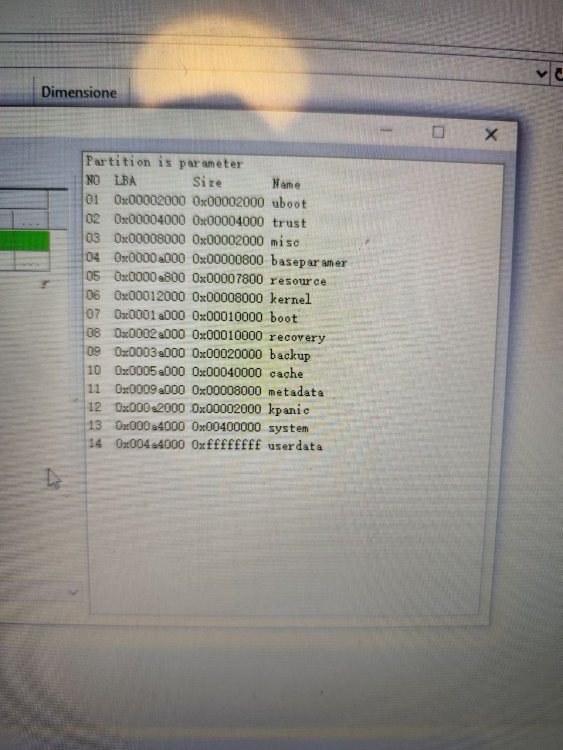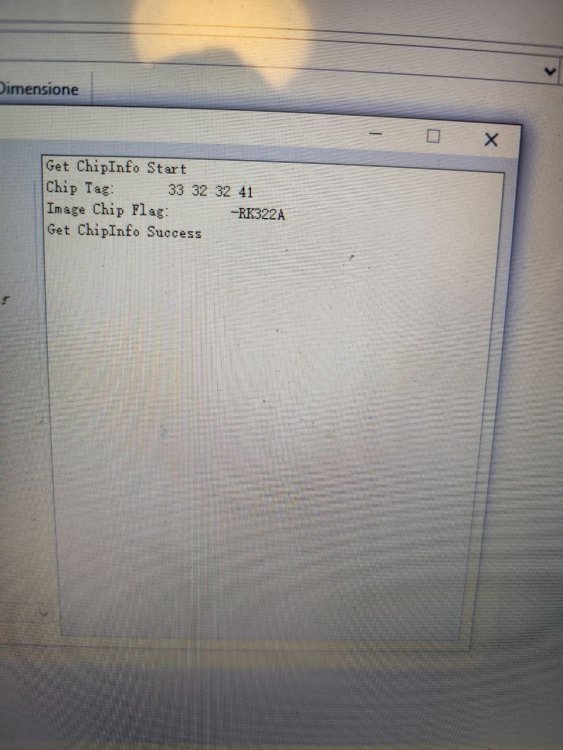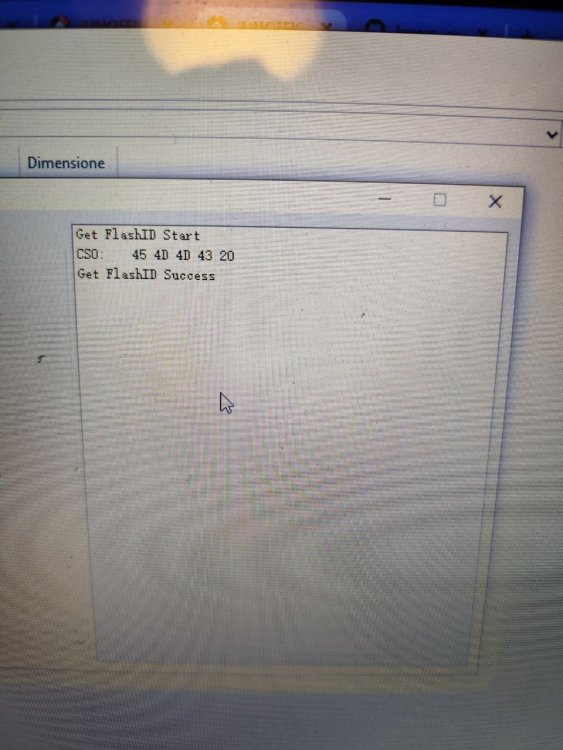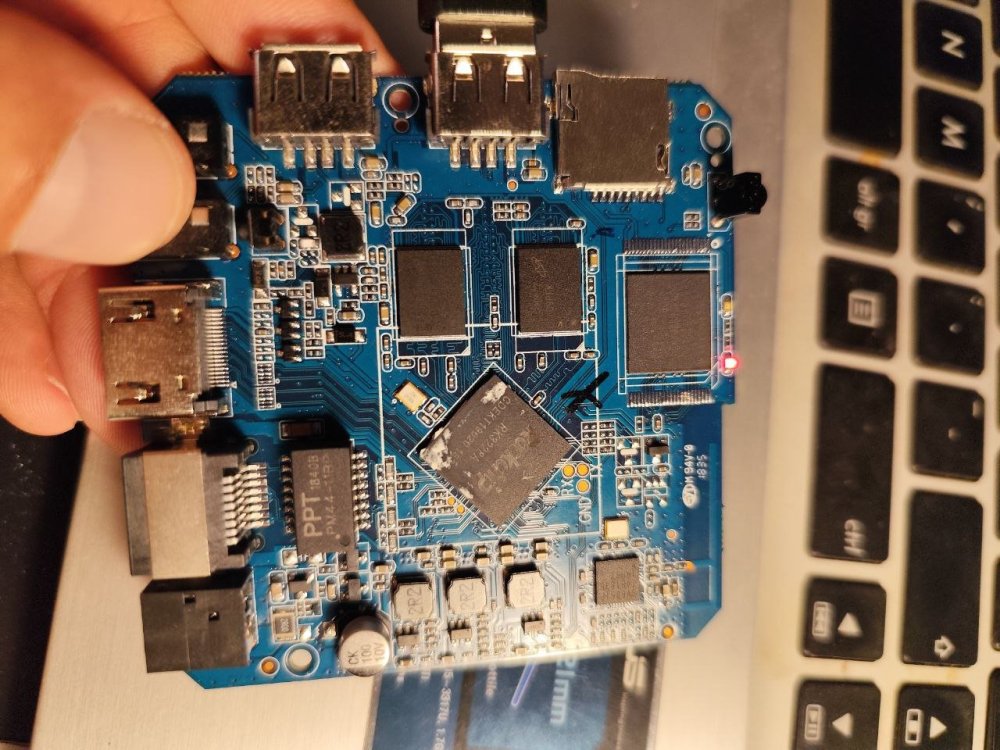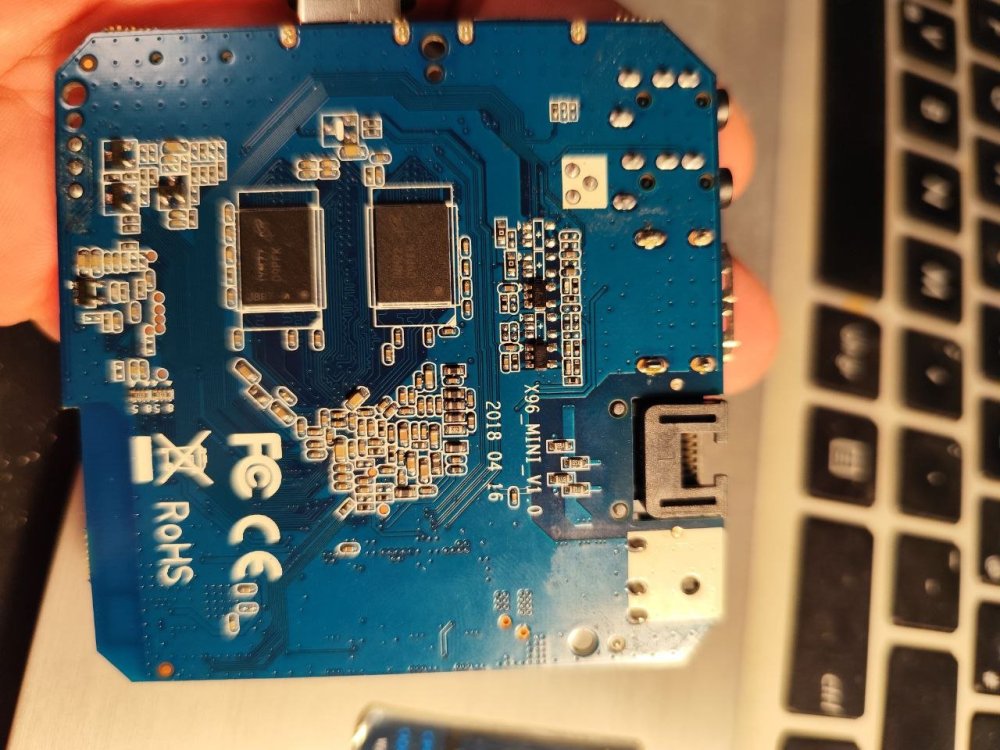All Activity
- Past hour
-

Gaming experience with Orange Pi 5 (RK3588) on Armbian
heyrict replied to KhanhDTP's topic in Orange Pi 5
Armbian Trixie XFCE (Edge kernel 6.18.0-rc3-edge-rockchip64) + Stable mesa 25.0.7-2 + box64-rk3588 0.3.9+20251106.dcd3ba0-1 (https://ryanfortner.github.io/box64-debs/) + wine-10.18-staging-tkg-amd64-wow64 (https://github.com/Kron4ek/Wine-Builds/releases) + dxvk-sarek v1.11.0-sarek-async-writeaccessfix-malifix-5d21d2b (https://github.com/pythonlover02/DXVK-Sarek/actions) Elin ~40fps@720p -
Hip hip hooray !!! Yep, this way worked. Will provide the all steps for people who have the same issue. $ apt install linux-u-boot-rock-5b-edge $ armbian-install # Just in case I've installed to the all partitions. I mean to 5th and 7th. > 5 Install/Update the bootloader on SD card (/dev/mmcblk1) > 7 Install/Update the bootloader on MTD Flash $ reboot And now I can enter to uboot shell change to F2: 1068MHz ch0 ttot12 ch1 ttot12 ch2 ttot12 ch3 ttot12 change to F3: 1560MHz ch0 ttot14 ch1 ttot14 ch2 ttot14 ch3 ttot14 change to F0: 2112MHz ch0 ttot16 ch1 ttot16 ch2 ttot16 ch3 ttot16 out U-Boot SPL 2024.04-armbian-2024.04-S830c-P0000-Hd72c-Vdfa5-Bb703-R448a (Oct 24 2025 - 02:33:30 +0000) Trying to boot from SPI ## Checking hash(es) for config config-1 ... OK ## Checking hash(es) for Image atf-1 ... sha256+ OK ## Checking hash(es) for Image u-boot ... sha256+ OK ## Checking hash(es) for Image fdt-1 ... sha256+ OK ## Checking hash(es) for Image atf-2 ... sha256+ OK ## Checking hash(es) for Image atf-3 ... sha256+ OK INFO: Preloader serial: 2 NOTICE: BL31: v2.3():v2.3-868-g040d2de11:derrick.huang, fwver: v1.48 NOTICE: BL31: Built : 15:02:44, Dec 19 2024 INFO: spec: 0x1 INFO: code: 0x88 INFO: ext 32k is not valid INFO: ddr: stride-en 4CH INFO: GICv3 without legacy support detected. INFO: ARM GICv3 driver initialized in EL3 INFO: valid_cpu_msk=0xff bcore0_rst = 0x0, bcore1_rst = 0x0 INFO: l3 cache partition cfg-0 INFO: system boots from cpu-hwid-0 INFO: disable memory repair INFO: idle_st=0x21fff, pd_st=0x11fff9, repair_st=0xfff70001 INFO: dfs DDR fsp_params[0].freq_mhz= 2112MHz INFO: dfs DDR fsp_params[1].freq_mhz= 528MHz INFO: dfs DDR fsp_params[2].freq_mhz= 1068MHz INFO: dfs DDR fsp_params[3].freq_mhz= 1560MHz INFO: BL31: Initialising Exception Handling Framework INFO: BL31: Initializing runtime services WARNING: No OPTEE provided by BL2 boot loader, Booting device without OPTEE initialization. SMC`s destined for OPTEE will return SMC_UNK ERROR: Error initializing runtime service opteed_fast INFO: BL31: Preparing for EL3 exit to normal world INFO: Entry point address = 0xa00000 INFO: SPSR = 0x3c9 ns16550_serial serial@feb50000: pinctrl_select_state_full: uclass_get_device_by_phandle_id: err=-19 U-Boot 2024.04-armbian-2024.04-S830c-P0000-Hd72c-Vdfa5-Bb703-R448a (Oct 24 2025 - 02:33:30 +0000) Model: Radxa ROCK 5 Model B DRAM: 16 GiB Core: 353 devices, 32 uclasses, devicetree: separate MMC: mmc@fe2c0000: 1, mmc@fe2d0000: 2, mmc@fe2e0000: 0 Loading Environment from SPIFlash... SF: Detected xt25f128 with page size 256 Bytes, erase size 4 KiB, total 16 MiB *** Warning - bad CRC, using default environment In: serial@feb50000 Out: serial@feb50000 Err: serial@feb50000 Model: Radxa ROCK 5 Model B rockchip_dnl_key_pressed: no saradc device found Net: No ethernet found. Hit any key to stop autoboot: 0 => Great Thanks a lot
- Today
-
What is easiest depends on the situation. If you feel comfortable enough to use dd to write bootloader, I just downloaded the -edge package from the beta apt package pool, extracted the .bin file and wrote it to correct location on SD-card, after saving the first 32k sectors also with dd to a backupfile. Then reboot and you know it. The qemu experiment was to boot directly from U-Boot to Btrfs raid1 filesystem, it took a lot of time browing through U-Boot config/compile options. Better/formal method is to install -edge package, it will remove -current package, then use armbian-config to write the bootloader explicitly.
-

Vontar KK MAX / HK1 RBOX R2 / R3 - RK3566 4GB/32GB(or 64GB)
Hqnicolas replied to Deoptim's topic in Rockchip CPU Boxes
Welcome to TV-Box section, that's the real size of your RAM: 4gb https://github.com/hqnicolas/Rockchip-Library/tree/main/RK356x/rkbin -

Cannot run ARMbian on my tv box (TX10 PRO)
erebus041 replied to erebus041's topic in Allwinner CPU Boxes
@Farhan Ishraq well you can download the bigtreetech cb1 images or the Yuzuki Chameleon images, its running just fine! -
Hi I'm looking to emulate an industrial device such as eWon or ESA router by using an sbc with dual eth and tailscale/headscale. What is the best and cheapest board? better if with a decent chassis. I'm interested in something like nanopi Rx or orangepi Rx. Any idea? thank you
-
Sigh ... Yeah I could see https://github.com/edk2-porting/edk2-rk3588?tab=readme-ov-file but for some reason I need exactly u-boot with enabled eth interface. So, it looks like I need to check -edge version too. However, you've mentioned qemu arm64 u-boot. So, It can be the way for me to check on my side all of these distributives before deploy it on a real hardware.
-

Cannot run ARMbian on my tv box (TX10 PRO)
Farhan Ishraq replied to erebus041's topic in Allwinner CPU Boxes
@Nick A@Sadiq AhmedHey Nick,I've tried to boot BigTreetech CB1[Provided by Sadiq] and a few more.But when i put Image burned sd card in TF slot and turn on the box but my screen didn’t get any hdmi output[for 3-4 minutes] then i removed the sd card from TF slot.I Don't have that much knowledge about SoC,Bootloader blah blah blah.Can you find any mistake or suggest me a compatible os? -
OK, it seems your SPI-flash is empty, so not used and skipped. I start to remember I think; ROCK5B -current is quite old and not from denx.de (or 'mainline') so I picked -edge, but I think I never wrote it to SPI, instead I have this in SPI: https://github.com/edk2-porting/edk2-rk3588?tab=readme-ov-file You need grub-efi or other efi capable and configured bootloader (hide boot.scr, add ESP partition) root@rock5b:~# strings /usr/lib/linux-u-boot-edge-rock-5b/u-boot-rockchip-spi.bin | grep "U-Boot SPL" U-Boot SPL 2024.04-armbian-2024.04-S830c-P0000-H1056-Vdfa5-Bb703-R448a (Jun 08 2025 - 03:38:17 +0000) My ROCK5B is 24/7 server, I won't reboot and do checks now, up to yourself to dig deeper and see how various versions are build. I remember there is a config option w.r.t. this 1 sec timeout, that I saw when building qemu arm64 u-boot a year ago. I currently have blocked u-boot and armbian packages, but will maybe configure/build for ROCK3A 2025.10, but that is completely other topic/issue.
-
I see from https://github.com/nextcloud/nextcloudpi/releases that 'pi' is sort of a synonymy for 'ARM SBC' or pre-installed images. 'pi' is great but a problem as it is not generic arm64 so every SBC flavor needs a 1GByte zip image just for a different kernel and bootloader. Same as long time ago I used a 'pi' script to get Node-RED installed in an x86 Debian Bullseye Virtual Machine (so just 'Debian' actually), I would focus on generic solutions. Armbian is doing very well w.r.t. alignment and portability, so the SoC or SBC does not really matter, as long as it is compliant with Debian ARM64. For Node-RED on Opensuse-Tumbleweed ARM64 I needed to hack the script a bit to fake a compliance check, but with that, it also worked. It saved an enormous amount of effort re-installing OS etc. So bottom line is, maker sure you don't lock yourself into a certain SBC or SoC, but make sure it is standard generic ARM64 (or standard x86-64, which is already the case for years) A way to keep your current installation is to 'virtualize' it: What runs on the Odroid or RaspberryPi or other SBC from SD-card or eMMC or NVME or SSD can be made EFI bootable and then it will run as virtual machine on the same SBC or other new/faster SBC of course as well. I have done this for RPI3B functions -> RPI4B in the past (also 32-bit VM in 64-bit host, Pi-Hole for example) and this year again to replace RPi4B-8GB with ROCK5B-16GB. It is beyond the scope of this topic, but start with installing 'virt-manager' and try to boot and Armbian-UEFI image/instance. Or see: https://github.com/nextcloud/vm I haven't used 'cloud' since owncloud, but right now, if I would certainly start with a VM. Same for e.g. HAOS, runs fine in a VM on ROCK5B. You do not need proxmox, all is build-in in Linux already.
-
$ apt list -a --installed linux-u-boot-rock-5b* Listing... Done linux-u-boot-rock-5b-current/now 25.8.2 arm64 [installed,local] linux-u-boot-rock-5b-current/noble 25.8.1 arm64 linux-u-boot-rock-5b-current/noble 25.5.1 arm64 linux-u-boot-rock-5b-current/noble 25.2.3 arm64 linux-u-boot-rock-5b-current/noble 25.2.2 arm64 linux-u-boot-rock-5b-current/noble 24.11.3 arm64 linux-u-boot-rock-5b-current/noble 24.11.1 arm64 linux-u-boot-rock-5b-current/noble 24.8.2 arm64 $ dpkg -L linux-u-boot-rock-5b-current /. /usr /usr/lib /usr/lib/linux-u-boot-current-rock-5b /usr/lib/linux-u-boot-current-rock-5b/idbloader.img /usr/lib/linux-u-boot-current-rock-5b/rkspi_loader.img /usr/lib/linux-u-boot-current-rock-5b/u-boot-config-target-1 /usr/lib/linux-u-boot-current-rock-5b/u-boot-defconfig-target-1 /usr/lib/linux-u-boot-current-rock-5b/u-boot-metadata-target-1.sh /usr/lib/linux-u-boot-current-rock-5b/u-boot-metadata.sh /usr/lib/linux-u-boot-current-rock-5b/u-boot.itb /usr/lib/u-boot /usr/lib/u-boot/LICENSE /usr/lib/u-boot/platform_install.sh /usr/lib/u-boot/rock-5b-rk3588_defconfig /usr/share /usr/share/doc /usr/share/doc/linux-u-boot-rock-5b-current /usr/share/doc/linux-u-boot-rock-5b-current/changelog.gz $ cat /usr/lib/u-boot/platform_install.sh # Armbian u-boot install script for linux-u-boot-rock-5b-current 2017.09-Sa317-Pedb0-H5208-Vc393-Bb703-R448a # This file provides functions for deploying u-boot to a block device. DIR=/usr/lib/linux-u-boot-current-rock-5b write_uboot_platform () { local logging_prelude=""; [[ $(type -t run_host_command_logged) == function ]] && logging_prelude="run_host_command_logged"; if [ -f $1/u-boot-rockchip.bin ]; then ${logging_prelude} dd if=$1/u-boot-rockchip.bin of=$2 bs=32k seek=1 conv=notrunc status=none; else if [ -f $1/rksd_loader.img ]; then ${logging_prelude} dd if=$1/rksd_loader.img of=$2 seek=64 conv=notrunc status=none; else if [[ -f $1/u-boot.itb ]]; then ${logging_prelude} dd if=$1/idbloader.img of=$2 seek=64 conv=notrunc status=none; ${logging_prelude} dd if=$1/u-boot.itb of=$2 seek=16384 conv=notrunc status=none; else if [[ -f $1/uboot.img ]]; then ${logging_prelude} dd if=$1/idbloader.bin of=$2 seek=64 conv=notrunc status=none; ${logging_prelude} dd if=$1/uboot.img of=$2 seek=16384 conv=notrunc status=none; ${logging_prelude} dd if=$1/trust.bin of=$2 seek=24576 conv=notrunc status=none; else echo "Unsupported u-boot processing configuration!"; exit 1; fi; fi; fi; fi } write_uboot_platform_mtd () { FILES=$(find "$1" -maxdepth 1 -type f -name "rkspi_loader*.img"); if [ -z "$FILES" ]; then echo "No SPI image found."; exit 1; fi; MENU_ITEMS=(); i=1; while IFS= read -r file; do filename=$(basename "$file"); MENU_ITEMS+=("$i" "$filename" ""); ((i++)); done <<< "$FILES"; if [[ $i -eq 2 ]]; then dd if=$1/${MENU_ITEMS[1]} of=$2 conv=notrunc status=none > /dev/null 2>&1; return; fi; [[ -f /etc/armbian-release ]] && source /etc/armbian-release; backtitle="Armbian for $BOARD_NAME install script, https://www.armbian.com"; CHOICE=$(dialog --no-collapse --title "armbian-install" --backtitle "$backtitle" --radiolist "Choose SPI image:" 0 56 4 "${MENU_ITEMS[@]}" 3>&1 1 >&2 2>&3); if [ $? -eq 0 ]; then dd if=$1/${MENU_ITEMS[($CHOICE*3)-2]} of=$2 conv=notrunc status=none > /dev/null 2>&1; else echo "No SPI image chosen."; exit 1; fi } setup_write_uboot_platform () { if grep -q "ubootpart" /proc/cmdline; then local tmp part dev; tmp=$(cat /proc/cmdline); tmp="${tmp##*ubootpart=}"; tmp="${tmp%% *}"; [[ -n $tmp ]] && part=$(findfs PARTUUID=$tmp 2> /dev/null); [[ -n $part ]] && dev=$(lsblk -n -o PKNAME $part 2> /dev/null); [[ -n $dev ]] && DEVICE="/dev/$dev"; fi } $ cat /dev/mtdblock0 > /tmp/spidump $ strings /tmp/spidump | grep -i U.*Boot nothing $ du -h /tmp/spidump 16M /tmp/spidump It seems something installed and configured but for -current not for -edge I thought that -current version more stable. Am I wrong and I need to install -edge ?
-
I usually fight a bit the default 80x25 serial terminal sizing (KDE konsole) via 'screen /dev/ttyUSB0 1500000', but tools like MidnightCommander can be used. Certainly all standard CLI stuff and copy-paste. So just some commands: apt list --installed linux-u-boot-rock-5b* dpkg -L linux-u-boot-rock-5b-edge cat /usr/lib/u-boot/platform_install.sh cat /dev/mtdblock0 > /tmp/spidump strings /tmp/spidump | grep -i U-Boot
-
Building a new image did not solve the issue. no output on lsusb when plugging in anything. no output related to usb on dmesg. I personally think it is related to missing dts information. I did find this: https://github.com/armbian/linux-rockchip/blob/rk-6.1-rkr5.1/arch/arm/configs/rk3506-usb-otg.config And this: https://github.com/armbian/linux-rockchip/blob/rk-6.1-rkr5.1/arch/arm/configs/rk3506-usb-host.config Which I hope will enable me to use the usb. Specifcially: CONFIG_USB_COMMON=y & CONFIG_USB_GADGET=y & CONFIG_USB=y Will see what I can do after work today since it is friday Also for my own information, Here is the dtsi for the rk3506: https://github.com/armbian/linux-rockchip/blob/rk-6.1-rkr5.1/arch/arm/boot/dts/rk3506.dtsi And also this one: https://github.com/armbian/linux-rockchip/blob/rk-6.1-rkr5.1/arch/arm/boot/dts/rk3506b-luckfox-lyra-zero-w-sd.dts
-
And since it contains no firmware payload output, no one can tell what you are running.
-
Thanks for answer I will try. Right now just waiting support from remote side. And maybe it can be helpful. I can see on my UART console only this [58160.278303] reboot: Restarting system ]DDR 9fa84341ce typ 24/09/06-09:51:11,fwver: v1.18 ch0 ttot10 ch1 ttot10 ch2 ttot10 ch3 ttot10 ch0 ttot16 LPDDR4X, 2112MHz channel[0] BW=16 Col=10 Bk=8 CS0 Row=17 CS1 Row=17 CS=2 Die BW=16 Size=4096MB ch1 ttot16 channel[1] BW=16 Col=10 Bk=8 CS0 Row=17 CS1 Row=17 CS=2 Die BW=16 Size=4096MB ch2 ttot16 channel[2] BW=16 Col=10 Bk=8 CS0 Row=17 CS1 Row=17 CS=2 Die BW=16 Size=4096MB ch3 ttot16 channel[3] BW=16 Col=10 Bk=8 CS0 Row=17 CS1 Row=17 CS=2 Die BW=16 Size=4096MB Manufacturer ID:0xff DQS rds:l0,h1 CH0 RX Vref:28.5%, TX Vref:23.8%,22.8% DQ rds:h4 h7 h1 h5 h5 l4 h6 h2, h6 h1 h6 h3 h3 h1 h2 h3 DQS rds:l0,l0 CH1 RX Vref:28.5%, TX Vref:23.8%,23.8% DQ rds:h4 h2 l0 h1 h1 h3 h1 h1, h3 h1 h6 h1 h1 l0 l0 h2 DQS rds:l0,l0 CH2 RX Vref:29.3%, TX Vref:23.8%,21.8% DQ rds:h2 h5 h7 h7 h6 l0 h3 h2, h1 h5 l0 h6 l0 h3 h7 h1 DQS rds:l1,h1 CH3 RX Vref:28.5%, TX Vref:24.8%,23.8% DQ rds:l0 h3 h7 l0 h3 h1 h2 h4, h1 h7 h7 h7 h2 h6 l0 h1 stride=0x2, ddr_config=0x4 hash ch_mask0-1 0x20 0x40, bank_mask0-3 0xa00 0x1400 0x2800 0x0, rank_mask0 0x401000 change to F1: 528MHz ch0 ttot10 ch1 ttot10 ch2 ttot10 ch3 ttot10 change to F2: 1068MHz 1;-1fdone. Begin: Mounting root file system ... Begin: Running /scripts/local-top ... done. Begin: Running /scripts/local-premount ... Scanning for Btrfs filesystems done. Begin: Will now check root file system ... fsck from util-linux 2.39.3 [/usr/sbin/fsck.ext4 (1) -- /dev/mmcblk1p1] fsck.ext4 -a -C0 /dev/mmcblk1p1 armbi_root: clean, 46692/7448320 files, 1142106/30126080 blocks done. done. Begin: Running /scripts/local-bottom ... done. Begin: Running /scripts/init-bottom ... done. Welcome to Armbian 25.8.2 noble! [ OK ] Created slice system-modprobe.slice - Slice /system/modprobe. # CTRL-A Z for help | 1500000 8N1 | NOR | Minicom 2.8 And in addition, I've tried to use fw_printenv -c /tmp/fw_env.config from u-boot-tools package. Just to print current u-boot config but it doesn't work for rock5b. Maybe I've prepared a wrong config $ cat /proc/partitions major minor #blocks name 179 0 121753600 mmcblk1 179 1 120504320 mmcblk1p1 31 0 16384 mtdblock0 252 0 8174096 zram0 252 1 51200 zram1 $ cat /tmp/fw_env.config /dev/mmcblk1p1 0xE5D800000 0x4000 # Where E5D800000 i've get by such way for mmcblk1p1 # echo "obase=16; 120504320*512"| bc -l # E5D800000 $ fw_printenv -c /tmp/fw_env.config Cannot read environment, using default Cannot read default environment from file $ fw_printenv -V 0.3.5 773 Sorry for mixing all the stuff to one topic but it seems a bit relevant with this topic.
-

Support for TC358743 CSI to HDMI on Radxa Zero 3W
opi-5-plus-user posted a topic in Radxa Zero 3W/3E
I have tried to get the CSI port working on my Radxa Zero 3W with the GEEKOM X1301 HAT, and now I can get the chip to show up in /dev, however there seems to be an issue when I try to access it, as I keep getting ioctl errors. I started by copying over the .dtbo files from the regular radxa official image, and putting them into the overlay-user folder in /boot. Then I enabled the radxa-zero3-tc358743.dtbo overlay, which gets the devices to show up. I am following this guide from GEEKOM https://wiki.geekworm.com/X1300_Software, however, I keep getting ioctl errors when trying to set the EDID file on the Radxa Zero. On the Raspberry Pi, this was not an issue. Here is the output of my media-ctl: media-ctl -d /dev/media0 -p Media controller API version 6.1.115 Media device information ------------------------ driver rkisp-vir0 model rkisp0 serial bus info platform:rkisp-vir0 hw revision 0x0 driver version 6.1.115 Device topology - entity 1: rkisp-isp-subdev (4 pads, 8 links, 0 routes) type V4L2 subdev subtype Unknown flags 0 device node name /dev/v4l-subdev0 pad0: SINK,MUST_CONNECT [stream:0 fmt:UYVY8_2X8/640x480 field:none colorspace:srgb crop.bounds:(0,0)/640x480 crop:(0,0)/640x480] <- "rkisp-csi-subdev":1 [ENABLED] <- "rkisp_rawrd0_m":0 [] <- "rkisp_rawrd2_s":0 [] pad1: SINK <- "rkisp-input-params":0 [ENABLED] pad2: SOURCE [stream:0 fmt:YUYV8_2X8/640x480 field:none colorspace:smpte170m quantization:full-range crop.bounds:(0,0)/640x480 crop:(0,0)/640x480] -> "rkisp_mainpath":0 [ENABLED] -> "rkisp_selfpath":0 [ENABLED] -> "rkisp_iqtool":0 [ENABLED] pad3: SOURCE -> "rkisp-statistics":0 [ENABLED] - entity 6: rkisp-csi-subdev (6 pads, 5 links, 0 routes) type V4L2 subdev subtype Unknown flags 0 device node name /dev/v4l-subdev1 pad0: SINK,MUST_CONNECT [stream:0 fmt:UYVY8_2X8/640x480 field:none colorspace:srgb] <- "rockchip-csi2-dphy0":1 [ENABLED] pad1: SOURCE,MUST_CONNECT [stream:0 fmt:UYVY8_2X8/640x480 field:none colorspace:srgb] -> "rkisp-isp-subdev":0 [ENABLED] pad2: SOURCE -> "rkisp_rawwr0":0 [ENABLED] pad3: SOURCE pad4: SOURCE -> "rkisp_rawwr2":0 [ENABLED] pad5: SOURCE -> "rkisp_rawwr3":0 [ENABLED] - entity 13: rkisp_mainpath (1 pad, 1 link) type Node subtype V4L flags 0 device node name /dev/video0 pad0: SINK <- "rkisp-isp-subdev":2 [ENABLED] - entity 19: rkisp_selfpath (1 pad, 1 link) type Node subtype V4L flags 0 device node name /dev/video1 pad0: SINK <- "rkisp-isp-subdev":2 [ENABLED] - entity 25: rkisp_rawwr0 (1 pad, 1 link) type Node subtype V4L flags 0 device node name /dev/video2 pad0: SINK <- "rkisp-csi-subdev":2 [ENABLED] - entity 31: rkisp_rawwr2 (1 pad, 1 link) type Node subtype V4L flags 0 device node name /dev/video3 pad0: SINK <- "rkisp-csi-subdev":4 [ENABLED] - entity 37: rkisp_rawwr3 (1 pad, 1 link) type Node subtype V4L flags 0 device node name /dev/video4 pad0: SINK <- "rkisp-csi-subdev":5 [ENABLED] - entity 43: rkisp_iqtool (1 pad, 1 link) type Node subtype V4L flags 0 device node name /dev/video5 pad0: SINK <- "rkisp-isp-subdev":2 [ENABLED] - entity 49: rkisp_rawrd0_m (1 pad, 1 link) type Node subtype V4L flags 0 device node name /dev/video6 pad0: SOURCE -> "rkisp-isp-subdev":0 [] - entity 55: rkisp_rawrd2_s (1 pad, 1 link) type Node subtype V4L flags 0 device node name /dev/video7 pad0: SOURCE -> "rkisp-isp-subdev":0 [] - entity 61: rkisp-statistics (1 pad, 1 link) type Node subtype V4L flags 0 device node name /dev/video8 pad0: SINK <- "rkisp-isp-subdev":3 [ENABLED] - entity 67: rkisp-input-params (1 pad, 1 link) type Node subtype V4L flags 0 device node name /dev/video9 pad0: SOURCE -> "rkisp-isp-subdev":1 [ENABLED] - entity 73: rockchip-csi2-dphy0 (2 pads, 2 links, 0 routes) type V4L2 subdev subtype Unknown flags 0 device node name /dev/v4l-subdev2 pad0: SINK,MUST_CONNECT [stream:0 fmt:UYVY8_2X8/640x480@10000/600000 field:none colorspace:srgb] <- "m00_b_tc35874x 2-000f":0 [ENABLED] pad1: SOURCE,MUST_CONNECT -> "rkisp-csi-subdev":0 [ENABLED] - entity 76: m00_b_tc35874x 2-000f (1 pad, 1 link, 0 routes) type V4L2 subdev subtype Sensor flags 0 device node name /dev/v4l-subdev3 pad0: SOURCE [stream:0 fmt:UYVY8_2X8/640x480@10000/600000 field:none colorspace:srgb] [dv.caps:BT.656/1120 min:1x1@0 max:10000x10000@310000000 stds:CEA-861,DMT,CVT,GTF caps:interlaced,progressive,reduced-blanking,custom] [dv.query:no-link] [dv.current:BT.656/1120 640x480p59 (800x525) stds:CEA-861,DMT flags:has-cea861-vic] -> "rockchip-csi2-dphy0":0 [ENABLED] The GEEKOM does seem to require some GPIOs, as shown in the second picture from this link https://geekworm.com/products/x1301, however, these all seem to be for audio functionality, which I have disabled. I currently only have the GEEKOM X1301 connected through the CSI Port to the Radxa Zero, as it physically cannot have the GPIOs and the CSI port connected at the same time. Here is the output of my /dev folder autofs crypto fuse hugepages input loop3 mem port rga stdout tty13 tty20 tty28 tty35 tty42 tty5 tty57 tty7 urandom vcs2 vcsa3 vcsu4 video0 video8 block cuse gpiochip0 hwrng iomux loop4 mmcblk1 ppp rk_cec sw_sync tty14 tty21 tty29 tty36 tty43 tty50 tty58 tty8 v4l vcs3 vcsa4 vcsu5 video1 video9 btrfs-control disk gpiochip1 i2c-0 kmsg loop5 mmcblk1p1 psaux rtc tty tty15 tty22 tty3 tty37 tty44 tty51 tty59 tty9 v4l-subdev0 vcs4 vcsa5 vcsu6 video2 watchdog bus dma_heap gpiochip2 i2c-2 kvm loop6 mmcblk1p2 ptmx rtc0 tty0 tty16 tty23 tty30 tty38 tty45 tty52 tty6 ttyFIQ0 v4l-subdev1 vcs5 vcsa6 vfio video3 watchdog0 cec0 dri gpiochip3 i2c-3 log loop7 mpp_service pts shm tty1 tty17 tty24 tty31 tty39 tty46 tty53 tty60 ttyS1 v4l-subdev2 vcs6 vcsu vga_arbiter video4 zero char fb0 gpiochip4 i2c-6 loop0 loop-control mqueue ram0 snd tty10 tty18 tty25 tty32 tty4 tty47 tty54 tty61 ubi_ctrl v4l-subdev3 vcsa vcsu1 vhci video5 zram0 console fd gpiochip5 iio:device0 loop1 mapper net random stderr tty11 tty19 tty26 tty33 tty40 tty48 tty55 tty62 uhid vcs vcsa1 vcsu2 vhost-net video6 zram1 cpu_dma_latency full hdmi_hdcp1x initctl loop2 media0 null rfkill stdin tty12 tty2 tty27 tty34 tty41 tty49 tty56 tty63 uinput vcs1 vcsa2 vcsu3 vhost-vsock video7 zram2 This is the error that I get when I run the command to set the EDID file. v4l2-ctl -d /dev/v4l-subdev3 --set-edid=file=1080P60EDID.txt VIDIOC_SUBDEV_S_CLIENT_CAP: failed: Inappropriate ioctl for device Is there any way that I can resolve this issue? The HAT's power LED doesn't light up for some reason, and the device also isn't detected when I plug in any other devices HDMI out into the HDMI IN on the HAT. - Yesterday
-
I fixed the shitty dd stuff i did previously. I got it to boot now. It seems that the partitions need to be included in the image for it to work. From inside the armbian image: mmcblk0 179:0 0 28.9G 0 disk ├─mmcblk0p1 179:1 0 4M 0 part ├─mmcblk0p2 179:2 0 12M 0 part └─mmcblk0p3 179:3 0 28.8G 0 part /var/log.hdd I will build my own img and see if there is anything I can do about the non working usb. I think it might likely be related to dts
-
LC_ALL=C apt update Hit:1 http://security.debian.org bookworm-security InRelease Hit:2 http://deb.debian.org/debian bookworm InRelease Hit:3 http://deb.debian.org/debian bookworm-updates InRelease Hit:4 https://download.docker.com/linux/debian bookworm InRelease Hit:5 http://deb.debian.org/debian bookworm-backports InRelease Hit:6 https://github.armbian.com/configng stable InRelease Hit:7 https://dtcooper.github.io/raspotify raspotify InRelease Hit:8 http://fi.mirror.armbian.de/beta bookworm InRelease Reading package lists... Done Building dependency tree... Done Reading state information... Done 1 package can be upgraded. Run 'apt list --upgradable' to see it. root@orangepi3-lts:~# apt list --upgradable Listing... Gotowe armbian-bsp-cli-orangepi3-lts-current/bookworm 25.11.0-trunk.439 arm64 [upgradable from: 25.8.0-trunk.49] N: There is 1 additional version. Please use the '-a' switch to see it
-
I see now with some examination this: [ 1.995057]3 614e0000-0000-4b53-8000-1d2800995194] No filesystem could moun ext4 [ 1.995269] [ 1.9g: VFS: Unable to mount root fs 002577] CPU2: stopping The reason for the missing characters is likely the shitty CH340 I have connected as the serial monitor. Should still be able to see the issue.
-
So I am not a person to give up on this I basically took the partition scheme of a working ubuntu img and inserted the armbian partition and got further along. I changed it to below and got further along! Check the log for more information. Hint it threw some panic stuff, I wasn't expecting much but got further along. Hope someone can see what is wrong and help me troubleshoot. sudo fdisk -l /dev/sdd Disk /dev/sdd: 28.85 GiB, 30979129344 bytes, 60506112 sectors Disk model: Storage Device Units: sectors of 1 * 512 = 512 bytes Sector size (logical/physical): 512 bytes / 512 bytes I/O size (minimum/optimal): 512 bytes / 512 bytes Disklabel type: gpt Disk identifier: 863CE3B9-B148-45D1-B850-79AC22F0EB72 Device Start End Sectors Size Type /dev/sdd1 8192 16383 8192 4M Linux filesystem /dev/sdd2 16384 40959 24576 12M Linux filesystem /dev/sdd3 65536 60504063 60438528 28.8G Linux filesystem screenlog.log
-
If you have used RadxaOS before there might be an older U-Boot variant in SPI-flash and at least on ROCK3A SPI take preference over SD-cards, so the Armbian U-Boot from SD-card is not use. AFAIR Radxa OS ROCK5 U-Boot does not have the 1 sec autoboot timeout and also uses extlinux script and not bootcmd. But I might mix-up versions and platforms. So rewrite SPI-flash from Armbian is option to fix it.
-
I have no clue of your Odroid hardware, but nextcloudpi there sudo ncp-config -> system -> info will start with an overview pi@nc-rspios5:~ $ sudo ncp-config Running nc-info Gathering information... NextcloudPi version v1.55.4 NextcloudPi image NextcloudPi_06-01-25 OS Debian GNU/Linux 12. 6.12.47+rpt-rpi-2712 (aarch64) ncp version 1.55.4 is only offered to running instances and no image is provided on github to start with. But this version offers support of nextcloud 31 which gives you some more month support, ncp maintainer is ttrying to get supprt done to nc 32. You may try sudo ncp-update and then sudo ncp-update-nc
-

Cannot run ARMbian on my tv box (TX10 PRO)
Nick A replied to erebus041's topic in Allwinner CPU Boxes
@Farhan Ishraq Have you tried the images in the link @Sadiq Ahmed posted? Download BalenaEtcher software. Write one of the bigtreetech cb1 images onto a SDcard. Put it in your box and boot. -
I think i find where all my trouble start. i can doownload to the box the rk322x_loader_v1.10.238_256.bin but i can't switch to the emmc. Does anyone have ideas of what to do?








